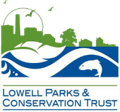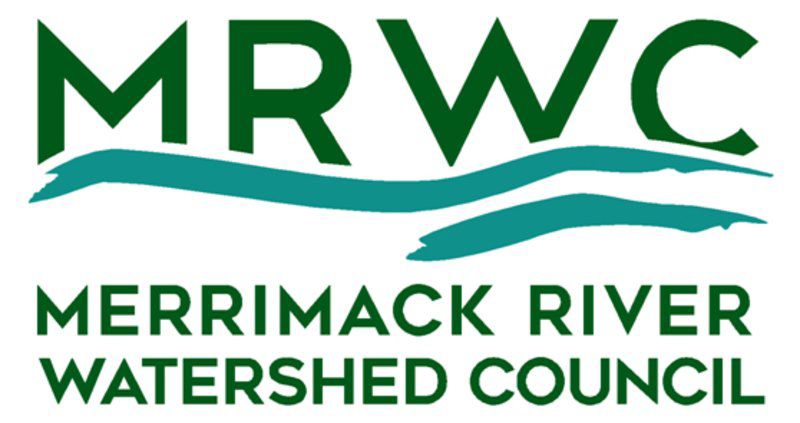Talbot Mills
Dam Removal
Quick Links:
Talbot Mills Dam
The Talbot Mills Dam, located on the Concord River in Billerica, is approximately 127 feet long and 10 feet high and was first built in 1711. The Concord River is part of the 399-square mile Sudbury-Assabet-Concord (SuAsCo) watershed, that runs northward from the headwaters of the Assabet and Sudbury rivers in Westborough to Concord where they join to form the Concord River, which then joins the Merrimack River in Lowell. From there the Merrimack flows northeast into the Atlantic Ocean/Gulf of Maine in Newburyport and Salisbury, Massachusetts.
The Talbot Mills Dam has a long and controversial past. Prior to its existence, the area was used extensively by Native Americans as fertile fishing grounds and as an important transportation route. The dam was first built for power supply and fire protection for the adjacent mill buildings. It later diverted water into the Middlesex Canal that connected Lowell to Boston using the water of the Concord River starting in 1803. Once built, the dam was believed to cause flooding for upstream farmers resulting in legal disputes and the dam being removed and rebuilt multiple times over nearly 150 years. The current dam was built in 1828 and is listed on the National Register of Historic Places. The dam now blocks the river that once sustained Native American populations with plentiful supplies of river herring and shad, preventing fish and other wildlife from migrating between the upper sections of the SuAsCo watershed and the Merrimack River and ocean.
In partnership with multiple state and federal agencies and local NGOs, the owner of the Talbot Mills Dam is seeking removal as the best solution to restore fish passage to the SuAsCo watershed, decommission aging infrastructure, eliminate ongoing maintenance and repair obligations, reduce upstream and downstream flood hazards, and improve water quality, aquatic habitat, and natural riverine processes. Throughout the dam’s history, it has caught the attention of past state and federal agencies and even Henry David Thoreau who spent years studying the river, the dam, and its impacts.
Benefits of dam removal
While the dam played an important role in the Industrial Revolution, it no longer serves that purpose and the many benefits of removal have come to outweigh the costs.
Fish Passage
The dam is a major barrier to fish passage, and removal will provide an unprecedented amount of habitat for five main species: alewife and blueback herring (commonly referred to together as “river herring”), American eel, American shad, and sea lamprey. All of these species are diadromous, which means they carry out part of their life in the ocean, and part in rivers and lakes in order to survive.

Blueback herring
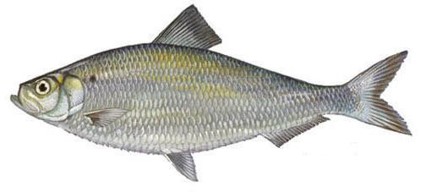
Alewife

American shad
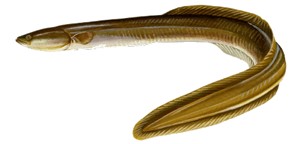
American eel

sea lamprey
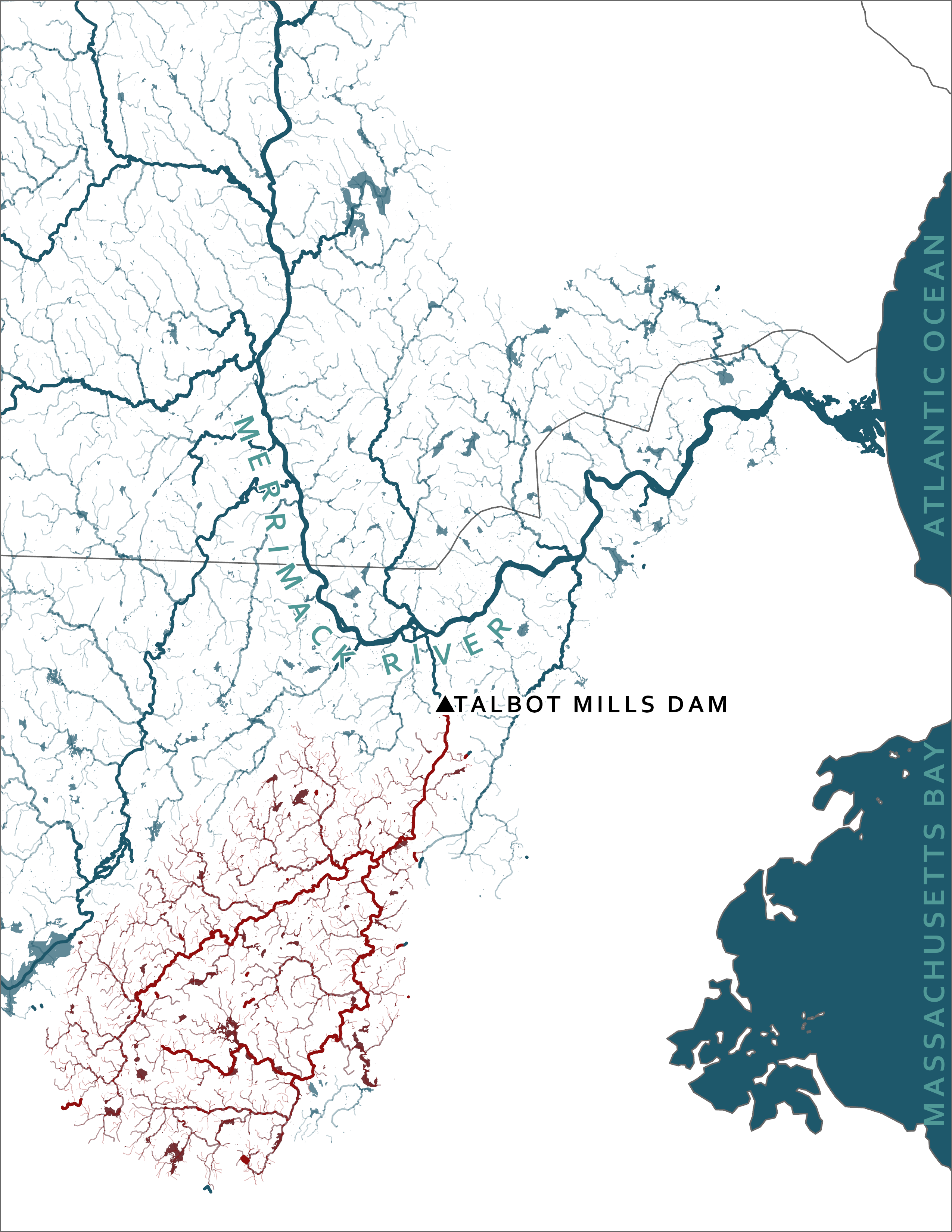
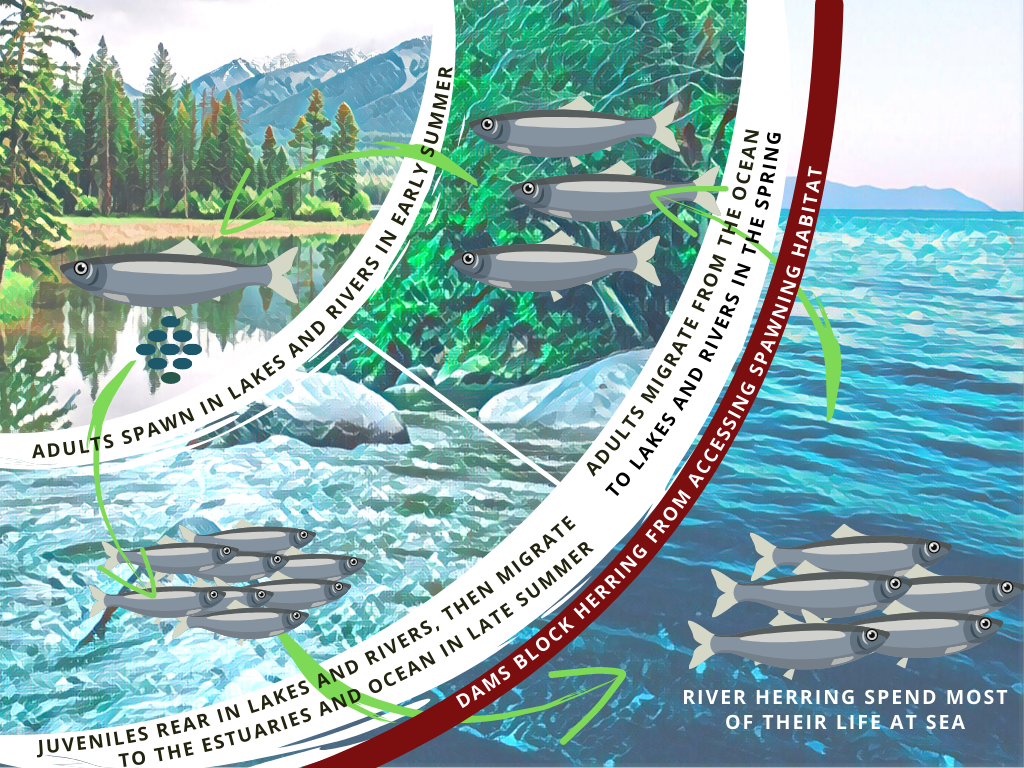
The Talbot Mills Dam currently blocks these species from 35 miles of mainstem rivers, 100 miles of tributaries, and 260 acres of lakes and ponds. Removing the dam would reconnect these rivers with the ocean. It is not just migratory and local fish who will benefit from being able to move up and downstream–all species who utilize the river benefit by being able to move freely. Turtles, otters, muskrats, beavers and many more species will benefit by accessing more habitat above and below the existing dam. Additionally, migratory fish like river herring and shad are an important component of the larger food web. Restoring the spawning habitat of these migratory fishes will not only help their populations to recover and increase resilience to climate change, it will also support many other species of fishes, mammals, and birds in the rivers and oceans that depend on them as a food source. This in turn will support both commercial and sports fisheries in the rivers and the Gulf of Maine.

Harbor seal

Great blue heron

Atlantic bluefin tuna

Bald eagle

Blanding’s turtle
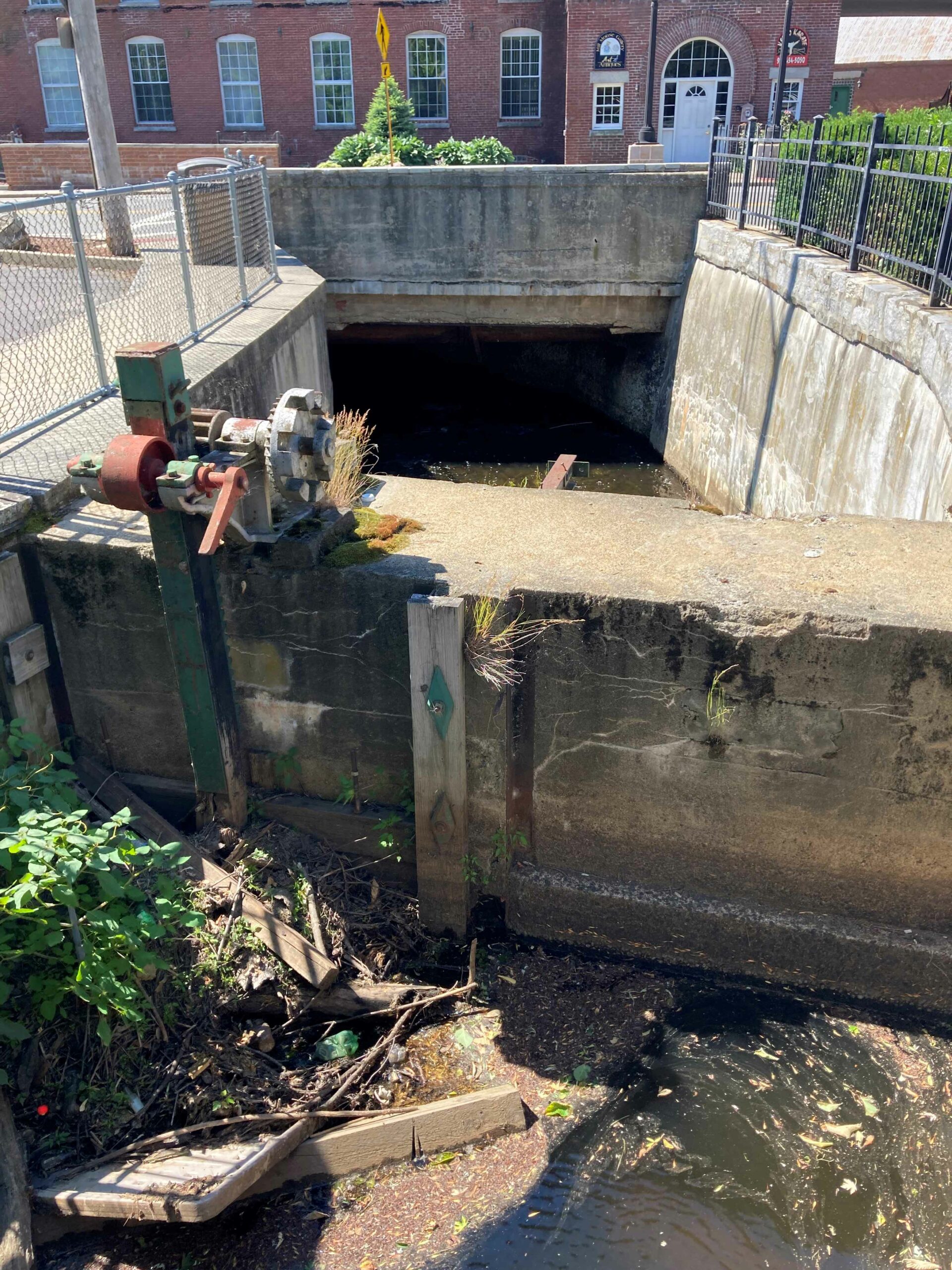
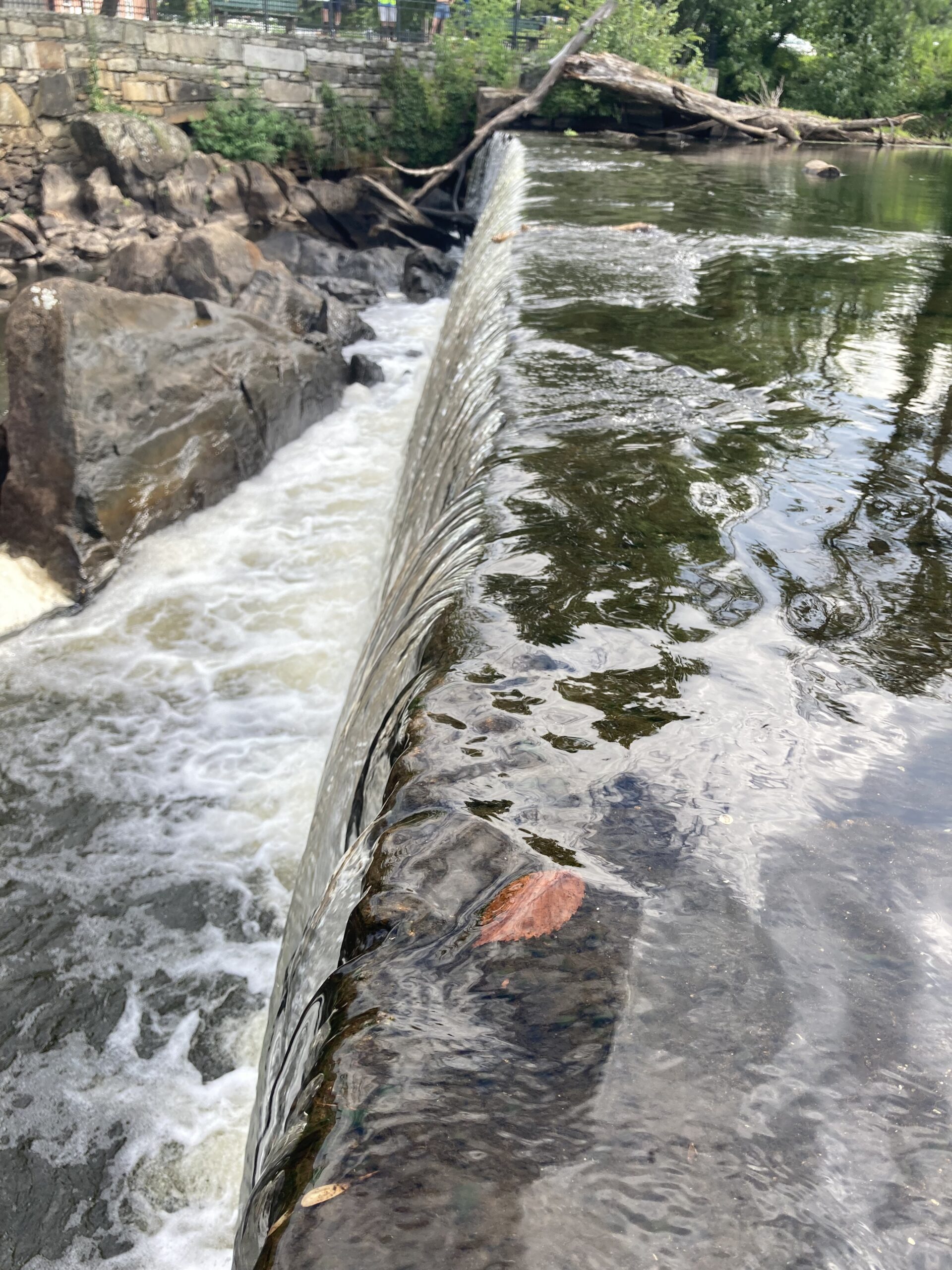
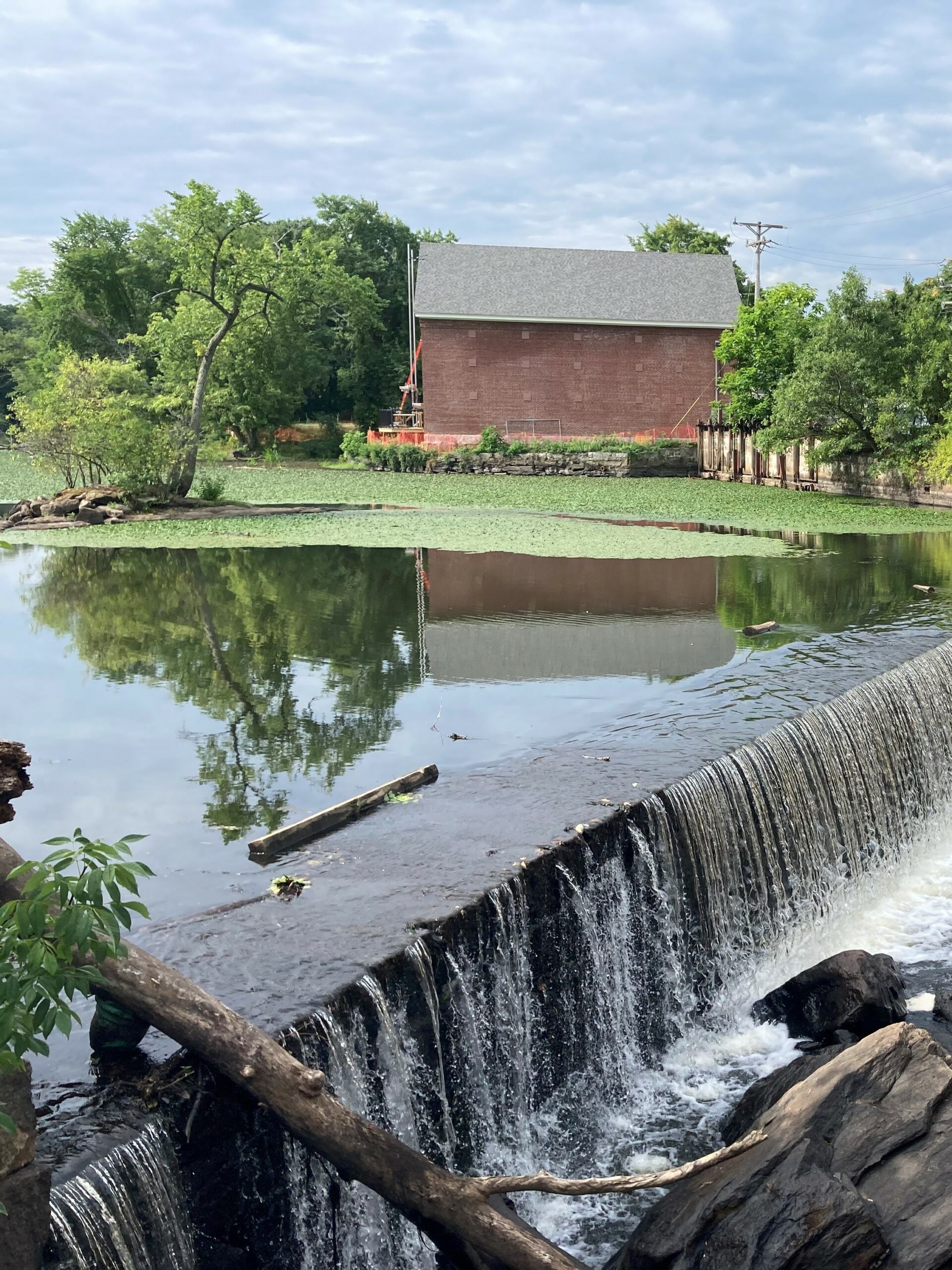

Water Quality
When water velocity is slowed, as it is behind a dam, the temperature increases as it’s warmed by the sun. This temperature shift, and associated water quality changes, can make the water uninhabitable for some species during the warmer months. The Concord, Sudbury, and Assabet Rivers have many dams, resulting in a compounding effect on temperature increase as the water moves downstream and spends time in the impoundments behind each dam. As temperature increases and water slows, dissolved oxygen decreases. Most aquatic organisms rely on oxygen dissolved in water to breathe, and limited dissolved oxygen can be deadly for aquatic life. Improving water quality does not only benefit aquatic life, however. Thousands of people currently get their drinking water from the Concord River and improved water quality will benefit them as well.
Improved riverine functions
The upstream areas of watersheds supply the downstream estuaries and marshes with sediment, nutrients, and all of the other components necessary for a healthy ecosystem. Dams block natural sediment and nutrient transport, disrupting their conveyance downstream, and often resulting in a buildup behind the dams. Excess nutrients, especially when compounded with warm water, can result in algae blooms, some of which may be toxic for people and animals, and other nuisance aquatic plants.
Flood mitigation
The dam creates an artificially higher water level upstream. Because it is a run-of-river dam, it does not control flooding downstream as some larger dams do. Removal of the dam would both reduce flooding upstream, and remove the risk of a catastrophic failure of the dam; which would release a significant amount of water at once, potentially flooding downstream properties.
Climate resilience and floodplain access
The Talbot Mills Dam is surrounded by development, which means the river channel upstream is currently constricted on either side. With the removal of the dam, the river width above the dam site will decrease as the natural channel returns, and some of its historical floodplain will be restored. When large storms occur, the river can then fill the floodplains with water, rather than the surrounding streets and properties. Larger floodplains also slow the speed of the water, which makes it less destructive as it moves downstream. As we expect more intense rainstorms with climate change, allowing the river to utilize these floodplains to manage flood water naturally will be particularly beneficial to the surrounding communities.
Invasive species reduction
Water chestnut is an invasive plant that grows on the surface of shallow, stagnant water. It currently covers the Mill Pond behind the Talbot Mills Dam. The dense mats of non-native vegetation crowd out native aquatic plants that provide food and shelter to native fishes, birds, and insects. Water chestnut also blocks sunlight from reaching the water and creates wild swings in dissolved oxygen in the water. When the plants decompose, they reduce the available dissolved oxygen. With the dam removed, the conditions that encourage water chestnut growth will be largely gone.
Healthier ecosystems
All of the above benefits together restore a river’s natural functions, resulting in a healthier ecosystem. When the river benefits, all of the systems that rely on it benefit as well. For example, a migratory bird that passes through the Concord River watershed and is able to feed on fish and insects, then has the nourishment to travel to another completely different ecosystem where the bird contributes to the food web and ecosystem functions. Fish that migrate up through the Concord River to spawn also feed bass, bald eagles, seals, whales, tuna, cod, and other fish and birds out in the ocean. These examples demonstrate how interconnected the SuAsCo watershed is with the greater ecosystem.
Recreation
The SuAsCo watershed is already a great place for people to enjoy canoeing, kayaking, rafting,fishing, picnicking and bird-watching along the rivers. Removal of the Talbot Mills Dam would provide an opportunity to engage in each of these activities in a new and different way. It is currently very difficult for boaters to get around the Talbot Mills dam.
Decommission Aging infrastructure
There are over 150 dams in the SuAsCo watershed. Many of these, including the Talbot Mills Dam, are privately owned. The Talbot Mills Dam is an intermediate-sized, significant hazard dam, meaning that due to its size and the amount of water stored behind it, failure of the dam could result in economic loss, environmental damage, disruption of lifeline facilities, or other impacts. As the dam ages and its condition deteriorates, this risk to the community downstream and the liability to the dam owner become more imminent.
Progress So far
While the Talbot Mills Dam removal project is just gaining new attention, this effort has been ongoing for decades. Multiple studies have been completed on the dam itself, as well as on the water quality and river health, fish populations near the dam, and impact on water supply infrastructure. This work has been funded by the Nyanza Chemical Waste Dump Superfund Site Natural Resource Damages (NRD) Trustee Council (comprising the Massachusetts Executive Office of Energy and Environmental Affairs, represented by the Massachusetts Department of Environmental Protection, US Fish and Wildlife Service, and the National Oceanic and Atmospheric Administration (NOAA)), the Massachusetts Division of Ecological Restoration (DER) Priority Project Program (selected as a Priority Project in Dec. 2021), DER’s Regional Partnerships Program, Massachusetts Environmental Trust, the Fuller Foundation and the National Park Services’ Wild & Scenic Rivers Program.
Here is a brief history of the studies that have been completed to date:
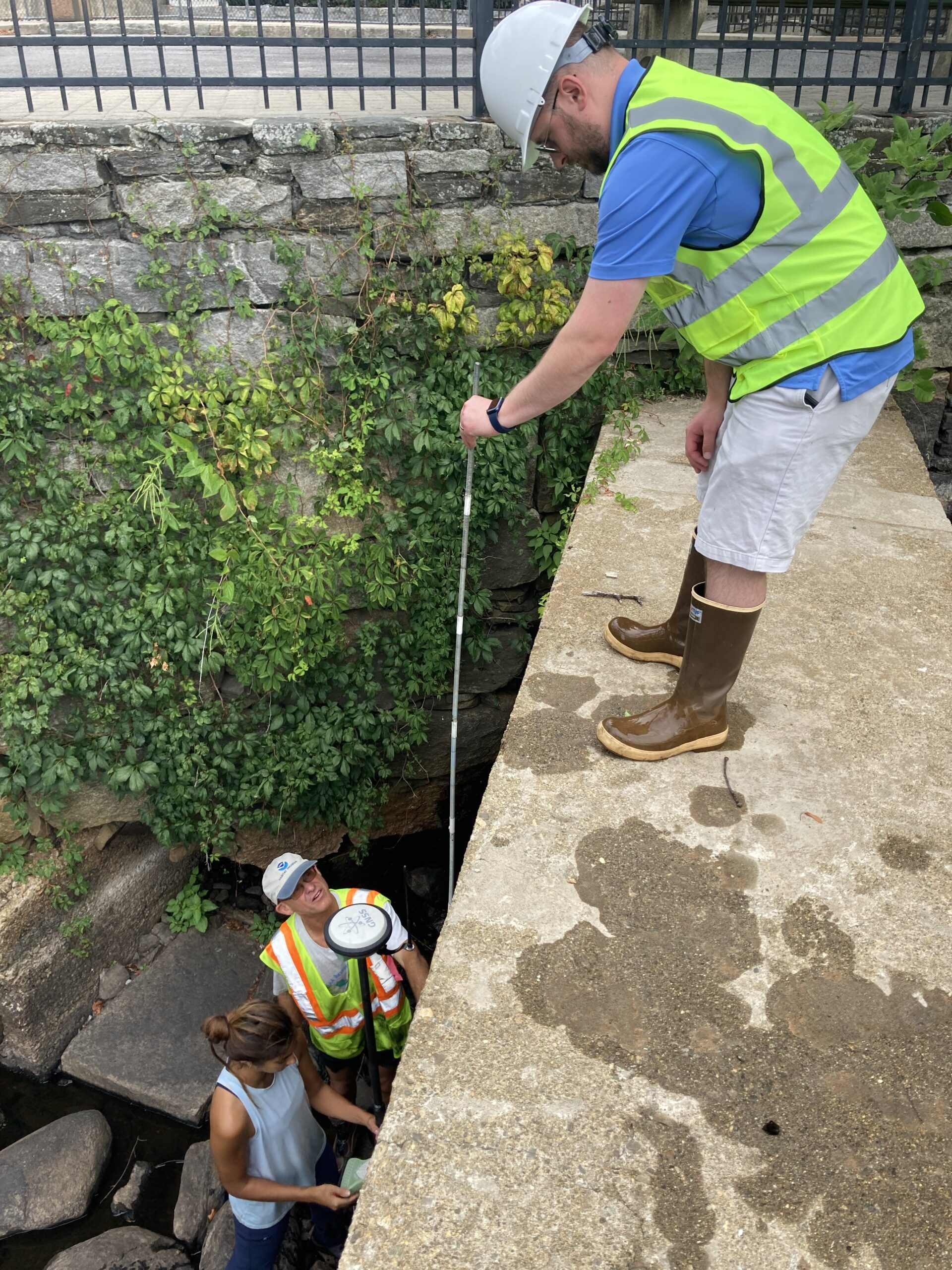
2016 Concord River Diadromous Fish Restoration Feasibility Study: In 2014, the Massachusetts Division of Marine Fisheries (DMF) contracted Gomez and Sullivan Engineers to study if and how fish passage to the Concord River watershed could be restored. In 2016 the study concluded that fish passage restoration is possible, with some modifications to the existing infrastructure in the river. Most notably, it was found that the Talbot Mills Dam is the primary blockage for fish accessing the SuAsCo watershed.
2020 Review of Talbot Mills Dam Removal Feasibility Study: In 2020, the Town of Billerica contracted Streamworks, PLLC to conduct a review of the 2016 Feasibility Study. Streamworks generally agreed with the findings of the study, and made suggestions for follow-up analyses.This review mentioned that removal of the Talbot Mills dam had the potential to improve water quality in Concord River.
2021 Merrimack River Comprehensive Plan for Diadromous Fishes: In 2021 the Technical Committee for Anadromous Fishery Management of the Merrimack River Basin, made up of representatives from federal and state agencies in New Hampshire and Massachusetts, completed a comprehensive plan for restoring diadromous fish populations to the Merrimack River Watershed. Removal of Talbot Mills dam was identified as a top priority project resulting in significant potential to restore fish populations to the Merrimack River watershed.
2021 Talbot Mills Dam Removal Targeted Impact Analysis: In 2021, DMF contracted Gomez and Sullivan Engineers to study the impacts that dam removal would have on the Town of Billerica’s drinking water intake, located 1.25 miles upstream of the dam. The study concluded that no significant impacts to the intake or water supply in general are expected from dam removal.
2022 Review of Targeted Impact Analysis: In 2022, the Town of Billerica contracted Streamworks, PLLC to conduct a review of the 2021 Targeted Impact Analysis. Streamworks found the conclusions of the analysis to be accurate and reasonable but suggested further studies. They supported Gomez and Sullivan’s recommendation to move forward with design and permitting of the dam removal.
2022 Talbot Mills Dam Removal–Intake Pump Performance Analysis: In 2022, the Town of Billerica contracted Woodard and Curran New England to also study the potential impacts that dam removal would have on the Town’s drinking water intake. The study concluded that dam removal would not likely cause issues at the intake structure. They recommended that the Town consider developing a second intake at another location on the river or an alternative water supply source due to the existing water quality concerns, and the Town having only one drinking water intake.
2022 Talbot Mills Dam Removal Conceptual Design: In 2022, DER contracted Gomez and Sullivan Engineers to develop a conceptual design for the removal of the Talbot Mills dam. This included an assessment of upstream and downstream impacts and an analysis of scour of existing infrastructure that could occur as a result of dam removal, and a plan for managing sediment behind the dam once the dam is removed.
2023 Talbot Mills Dam Removal Preliminary Design: In 2023, OARS contracted Gomez and Sullivan Engineers to advance the dam removal design to the preliminary (permit-ready) stage. 60% complete drawings were included with the MEPA EENF filing, and 75% complete drawings were included with the MEPA SEIR filing (see links to these documents below under Regulatory Review).
Regulatory Review
T
The environmental review process for the Talbot Mills Dam Removal Project under the Massachusetts Environmental Policy Act (MEPA) has been completed. The Secretary’s Certificate for the Single Environmental Impact Report (SEIR) was issued on April 1, 2024, stating that the SEIR “adequately and properly complies with MEPA.” The state-level MEPA process gathers information to ensure that all relevant environmental information is in hand before any permitting processes begin. The Single Environmental Impact Report (SEIR) was published in the Environmental Monitor on February 23, 2024. The SEIR is a comprehensive description of the project with detailed project plans, answers to questions raised in the Secretary’s Certificate for the Expanded Environmental Notification Form (EENF), and responses to the comments submitted by the public and others. All filings and Certificates can be downloaded from MEPA’s Talbot Mills summary page.
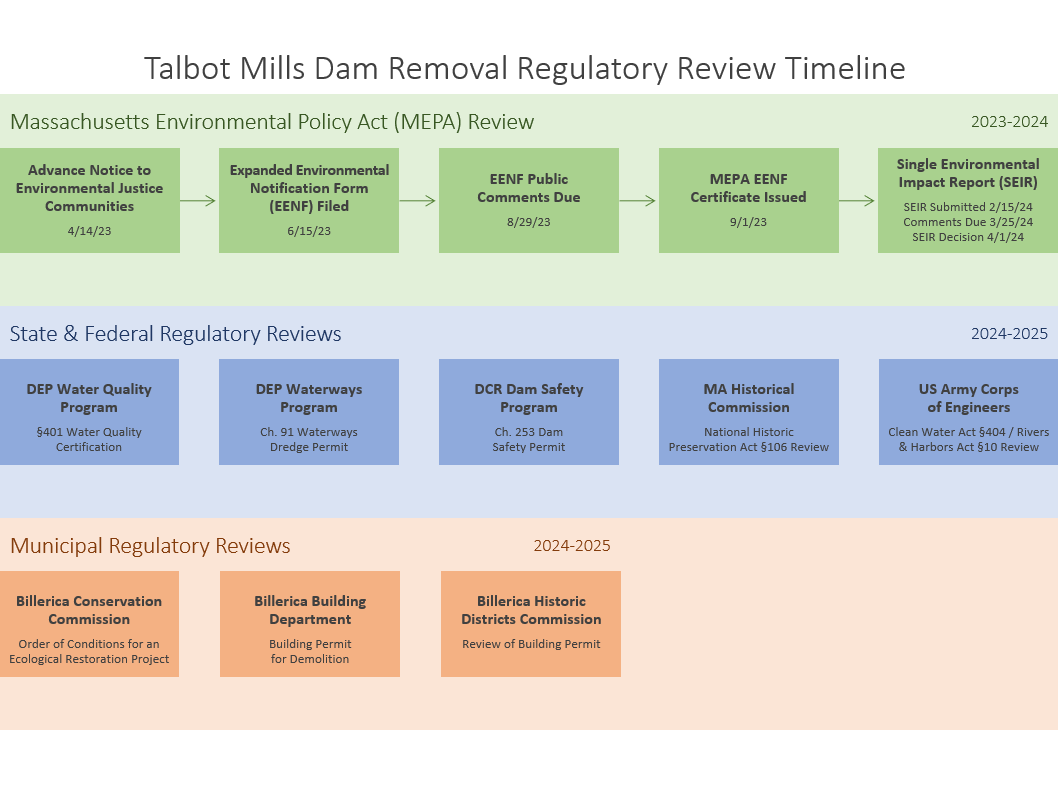
Public Meetings
Several public meetings, workshops, and other events will occur throughout the project where you can learn more and get involved. The meetings that have occurred so far are:
-
-
-
- August 7, 2014: The project team held a public information session. The session was held in-person and no recording is available.
- February 23, 2016: The project team held a public meeting. The meeting was held in-person and no recording is available.
- May 15, 2022: Members of the project team presented to the Middlesex Canal Association. Watch the recording here.
- June 29, 2022: The project team held a public meeting about the Talbot Mills Dam removal. Watch the recording here.
- April 10, 2023: Members of the project team gave an informational presentation to the Billerica Planning Board.
- April 12, 2023: Members of the project team gave an informal presentation to the Billerica Conservation Commission.
- April and May, 2023: OARS, one of the project leads, made informal presentations to various community groups in and around Billerica. Additional meetings and events will be held throughout the project. Sign up for email updates below to be notified when a meeting is upcoming or click the link to see if there are any upcoming events scheduled for this project.
- July 19, 2023 at 5:30 PM. MEPA held a remote consultation. View the meeting slides here.
- July 27, 2023 at 11 AM. MEPA held a site visit at the dam. View the handout here.
-
-
In the News
A variety of news outlets have reported on Talbot Mills over the years. Read a few recent articles below.
- May 16, 2023 – Town officials, conservation groups disagree on fate of Talbot Mills Dam
- September 15, 2022 – Removing dams restores river ecology, here’s how Massachusetts is stepping up
- August 12, 2022 – LTC Covers The Merrimack and Concord Rivers – Talbot Mills Dam Removal Project
- June 29, 2022 – Historic Talbot Mills dam meeting hears public concerns in Billerica
- June 27, 2022 – Talbot Mills Dam removal in Billerica would return Concord River flow, fish populations
- June 26, 2022 – The Five Minute Read. Dams, roads, polls and drone news
- June 21, 2022 – Fishing for a dam change at Talbot Mills dam in Billerica
- March 13, 2016 – It’s historic water over the Talbot Dam
Still have Questions?
1. Read our full FAQ document which is updated regularly. If you don’t find your questions there, submit yours to be answered in the next update!
2. Visit our StoryMap, a tool to view information about the project in a visual and accessible way.
3. Reach out to any of the contacts below about the project and information posted here:
- Matt Brown, OARS: mbrown@oars3rivers.org
- Eric Hutchins, NOAA: eric.hutchins@noaa.gov
- Jane Calvin, Lowell Parks and Conservation Trust: jcalvin@lowelllandtrust.org
The development of this webpage was funded in part by the Massachusetts Environmental Trust. For more information, please visit www.mass.gov/eea/met











